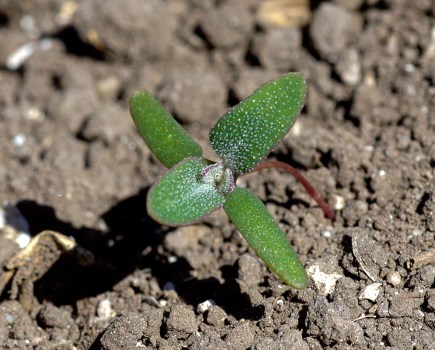Despite being a key component in crop nutrition, the latest data suggests that sulphur levels in crops are declining rapidly. CPM explores the current outlook and asks the experts how growers can rectify this.
“If ever there was a year to measure properly and know where you stand nutritionally, then this is it.” – DAVID BOOTY
By Charlotte Cunningham
While both environmental protection and public health have undoubtedly benefitted from a national directive to lower emissions across the board in recent years, something that’s been negatively impacted is sulphur levels in agriculture.
Sulphur is an essential nutrient for crop growth, playing a critical role in the synthesis of amino acids, enzymes, and proteins. Historically, sulphur deficiency was rarely a concern in the UK due to ample deposition from industrial emissions.
This atmospheric deposition – primarily in the form of sulphate – has long served as a natural source of plant-available sulphur, however, during the past few decades, stringent environmental regulations aimed at reducing air pollution have led to a significant decline in atmospheric sulphur deposition.
In fact, according to statistics from the UK Centre for Ecology and Hydrology (UKCEH), sulphur emissions have decreased by more than 90% since the 1970s, following the introduction of the Clean Air legislation which brought about a move to low-sulphur fuels.
The UK’s sulphur deposition levels, which once averaged 50–60kg/ha/ year in the 1970s, have now fallen below 5kg/ha/year in many regions. While this has significantly improved air quality and environmental health, it’s left UK farmers reliant on alternative sources to meet crop sulphur demands.
Where deficiencies are present, it can lead to a host of challenges for crops – largely due to sulphur’s role in nitrogen use efficiency – including reduced yields, poor soil health and nutrient cycling, and a deterioration in crop quality.
Exacerbating an already declining level of sulphur, extreme weather patterns during the past few seasons – namely, high levels of rainfall – have left soils susceptible to leaching of this highly soluble nutrient. The impact of this is very low availability in soils, suggests Omex’s David Booty. “Sulphate resources can deplete very quickly – just like nitrogen. During the past two years particularly, many growers have experienced heavy, excess winter rainfall. The result of this is very depleted soils.” Despite this outlook, David says application rates of sulphur have fallen too, with data from the British Survey of Fertiliser Practice indicating application rates on arable land have decreased from an average 35kg/ha in 2018/19, to 28kg/ha in 2022/23. “I think this partly comes down to financial pressures as we’re seeing application rates of phosphate and potash fall as well,” he notes.
“But also, there’s been more straight imported urea used during the past year, mainly because it was a cheap option, however, there probably wasn’t an option to have sulphur with it. If we look at our own nitrogen products, about 95% of what we sell is a blend of nitrogen and sulphur.
“If you just use straight nitrogen to save money – without buying sulphur from somewhere else – then you’re missing a trick.”
Now, the worry is that this could be constraining yield in a way it hasn’t done before, warns David. “The important thing to remember with sulphur is that even if the correct levels of other nutrients are applied, they’re not going to work in the absence of this key nutrient, largely due to its role in nitrogen use efficiency.”
INDEPENDENT TRIALS
Delving deeper into just how impactful the absence of sulphur can be on crop yields, independent trials carried out at Omex’s research site at Heckington in Lincolnshire last year (2024) revealed some stark results (see graph).
“The trials compared the use of straight nitrogen applied at 210kg/ ha, with a nitrogen-sulphur blend. In terms of how they were applied, we did a standard three-split application because that’s what growers would typically do, but we also looked at a two-split application. This is because in our experience, you can often achieve the same results in feed wheat using two equal splits as you would do with three.”
Looking at the results, David says they saw grain yield responses ranging 1.25-2.0t/ha from the inclusion of sulphur, with the same rate of nitrogen. “Personally, I’ve never seen responses as significant as that before.”
Independent laboratory NRM – a division of Cawood Scientific – has also been looking at declining sulphur levels via tissue analysis through
its CropCheck programme. “The programme involves growers sending us their samples from February onwards – essentially when crops
are actively growing – and we do a dry weight analysis to assess what’s happening in terms of crop nutrition,” explains the firm’s Dr Sajjad Awan.
Plotting the data for around 1200 samples from winter wheat collected GS32-37 between 2021 and 2023, Sajjad says there was a high concentration of sulphur deficient samples collected in 2021 particularly.
“In 2022, you can see on the graph (see graph ‘CropCheck winter wheat tissue analysis sulphur levels GS32-37 (2021-2023)’) that the curve isn’t overlapping and shifted more towards the right side compared with 2021 or 2023, which means more of the samples had sufficient sulphur levels during this year,” he explains.
“When you compare this against yield – based on statistics from Defra – they show the highest yield was achieved during 2022.”
Sajjad adds that a similar pattern emerged through the nitrogen analysis of the same tissue samples, as such, he set about trying to prove the importance of sulphur as both a standalone nutrient and its role in improving nutrient use efficiency, particularly nitrogen. “The next question I asked myself is what else can be done to find out why it’s so important and that it’s sulphur which is playing the main role in improving crop yield?”
As a result, he created correlation matrix graphs. “These graphs show both positive and negative correlations amongst different nutrients with the plant tissue.”
Sajjad says this exercise revealed the strongest correlations were between nitrogen and sulphur. “But it doesn’t stop there, there were also strong positive correlations between sulphur and phosphorous, as well as potassium, magnesium, zinc and boron.
“What we can say based on this data is that sulphur is the most important nutrient to help the uptake of others, and we can state that with moderate confidence now as we have the data to back it up.”
Contextualising this with the fall in atmospheric sulphur and climate change-related leaching from soils, Sajjad says it’s a concerning time for arable crops and as such, it’s important to take action. “I believe we’ve reached that tipping point.
“A lot of us talk about the cliff edge, but we’ve been moving towards the edge of the cliff for the past few years and have now fallen off. That’s why I believe sulphur needs a higher priority – among other nutrients – to ensure it’s present when the crop is actively growing and that growers are optimising sources of sulphur which are readily available.”
With this symbiotic relationship very apparent, he carried out what he coins a ‘grain test postmortem’, to provide further analysis on how well crop nutrient management plans have – or haven’t – worked. “Your grain tells you how much nutrients have been taken up and essentially check how well balanced your nutrient management plan is,” explains Sajjad.
Between the 2021-2023, the data showed 42% of samples were below target range for nitrogen, 43% for phosphorous, 11% for potassium and 41% for sulphur. “This further proves the deficiency challenge currently facing growers and is evidence that something has to be done to protect the sustainability of both crops and soils,” he stresses.
RB209 GUIDANCE
According to AHDB Nutrient Management Guide (RB209), if a deficiency is suspected, tissue and grain analysis can help confirm it. If diagnosed, the deficiency should be treated accordingly. More advice on correcting deficiencies can be found on page 26.
With the relationship between sulphur and nitrogen fundamental in crop growth, as growers head in anticipation towards the spring, David advocates carrying out a soil mineral nitrogen test as soon as possible. “Before planning what you’re going to do, you have to know what you already have. This is particularly important where there’s high uncertainty, and by that, I mean where growers aren’t sure what their losses from winter rainfall might be, or where they’ve changed farming system, for example.
“There are a lot of people going down the regen route now but it’s not always known what effect this is having on the soil unless it’s being measured. If ever there was a year to measure properly and know where you stand nutritionally, then this is it.”
David adds that a lot of focus is now on soil health and keeping its microbiome working, but that requires a certain amount of nitrogen to flourish. “If we under-fertilise crops they’ll tend to mine the soil for nutrients.
“If there is less leftover year-on- year, that’s going to negatively impact both yields and the soil microbiome for years to come,” he concludes.
This article was taken from the latest issue of CPM.
For more articles like this, subscribe here.
Sign up for Crop Production Magazine’s FREE e-newsletter here.




